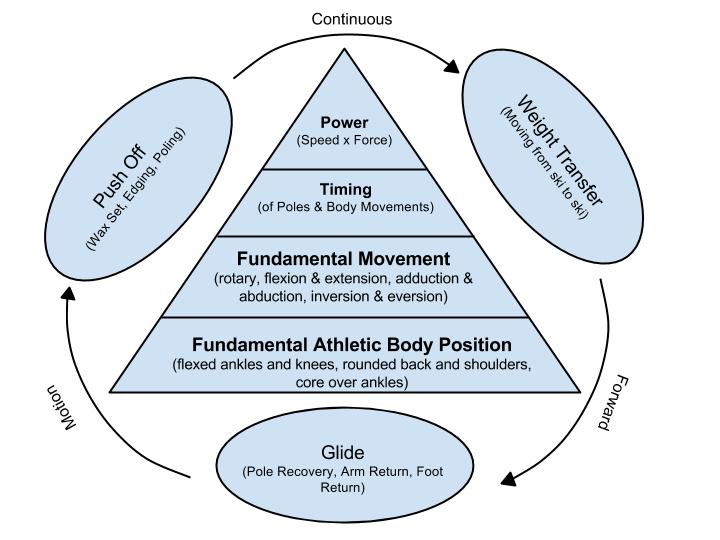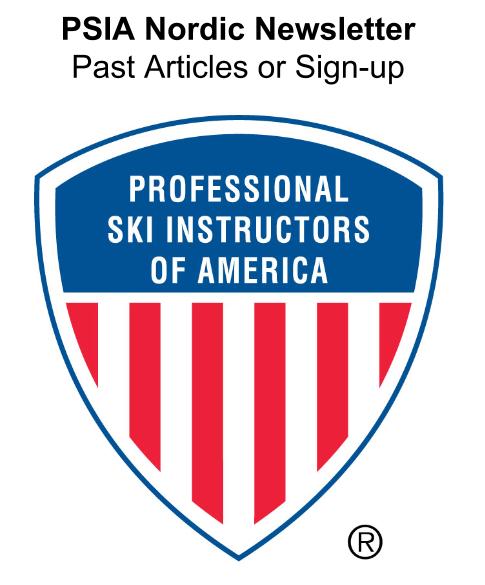PSIA & USSA New XC Technical Coaching and Teaching Model
/How To Think & Teach Cross Country Skiing
In this video, David Lawrence describes PSIA's new XC Technical Model. The model was developed by PSIA, in conjunction with USSA, for cross country skiing, both skate skiing and classic skiing and for coaches and instructors. The model combines USSA's Sports Performance Triangle with PSIA's XC Skills Concept.
Together, these two elements allow coaches and instructors to speak and think about cross country skiing in a universal, meaningful and accurate way. The model is broad enough for precise, physiological technical accuracy or general impressions and conceptual teaching exercises many coaches and instructors use.
The model won't necessarily make you a better skier, but it will help you understand what we do and how to think about nordic skiing.
Below is a quick graphic describing the technical model
Why a Cross Country Skiing Technical Model?
During PSIA’s annual team training event, an event where the PSIA Alpine, Snowboard, Freestyle, Adaptive, Telemark and Cross Country teams gather to plan, set goals, train with the national office staff and work, the XC team focused like a laser on a new XC Technical Model.
The primary goals of the model...
to:
- organize XC (skate and classic) movements into a short list of primary skill sets
- create a foundational, sport specific structure in order to inform coaches and instructors
- create a simple but effective movement analysis tool
- unify how we discuss, write and think about XC skiing
Why Another Model?
When I introduced the new model to a long time friend, instructor and avid master skier, he said, “After all the PSIA models that I’ve heard over the years, why do we need another one? All I have to say is that this better blow me away!” Guess what? The model completely underwhelmed him!
Great!!!
Why great? Because the model is nothing new. The strength of the model lies in its simplicity and flexibility. The new model doesn’t create new controversy or debate, instead it takes the fundamentals of skiing and organizes them into an effective, easy to follow, universal structure to to help coaches and instructors with movement analysis and technique communication.
Our previous models didn’t nail accuracy or simplicity; instead, many users of previous models had to learn new terms, concepts and ideologies to grasp the ideas of the model. Other models tried in the past, like the Alpine Skills Model (Rotary, Pressure, Edging, Balance) or USSA’s Sports Performance Pyramid (Body Position, Timing, Power) or PSIA XC Skills Model (ski-to-ski balance, push-off, poling, rhythm, edge control, and relaxation), didn’t get skiers, coaches or instructors to where they wanted to go.
The New “XC Technical Model”
Our new model combines USSA’s Sports Performance Triangle with PSIA’s new XC Skills Model.
How It Works
USSA’s Sports Performance Triangle organizes the “ingredients” of all sports, whether describing what an athlete does when playing tennis, ping-pong, basketball, football, downhill skiing or cross country skiing. These “ingredients” common to all sports are: fundamental athletic body position, fundamental movements, timing and power.
When you combine body position, movements, timing and power together, the resulting outcome produces “sport specific skills.” For cross country skiing, both skate and classic, the “sport specific skills” a skier does are: push-off, weight transfer and glide.
The Sports Performance Model
Fundamental Athletic Body Position describes the starting position of almost all sports. Fundamental movements are the universal and absolute movements the body can do like flexing and extending, adduction and abduction, etc. Timing is a quality of those movement, specifically how we coordinate those movements together (basic example, the abs, ankles and knees flex simultaneously during the push-off of the poles and ski). "Simultaneously" being the operative timing word to describe how the movements are coordinated. Power refers to the frequency/speed/tempo and the force applied to the movements (speed + force). In other words, how hard and fast we do the move (basic example, the arms accelerate just before planting the poles, then slow only a little to finish the poling stroke). We would describe the impulse move to set the wax pocket in terms of how fast and how hard we make the move. Consequently, there aren't "power movements" per say, but qualities of the movements that describe the power applied.
The XC Skills Model
The skills are sport specific, the performance triangle is universal. The whole model is actually universal, with only the skills in the model specific to the sport. Push-off broadly describes pushing off the ski either by edging, setting the wax pocket or pushing on the poles. Weight transfer broadly describes moving the center of mass in the direction of the new ski. Glide broadly describes what a skier does after landing on the new glide ski.
Closing Thoughts
The model represents nothing new. The model is an organizational concept, not a performance standard. The model is designed to help coaches and instructors see & think in patterns. The model is broad and flexible enough to evolve over time and adjust to changing terminology, but the basic tenants won’t change.




